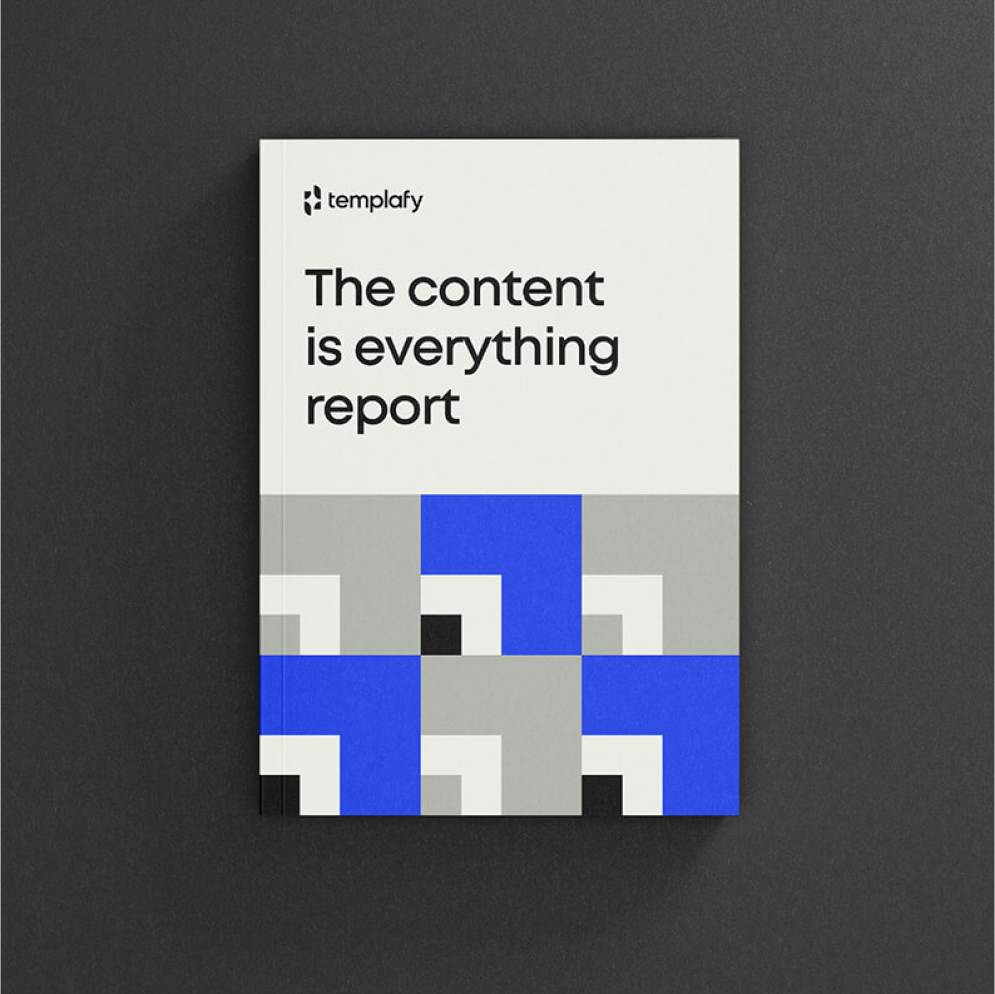Branded content explained: What it is, why it matters, and how to get it right

From marketing collateral to business-critical docs, here’s how branded content keeps your brand strong.
No one wants to be sold to—they want to be understood. That’s where branded content comes in.
Branded content is content that tells a story, sparks emotion, or shares something useful while staying true to your brand’s voice and values. It doesn’t scream “buy now.” Instead, it builds trust by showing who you are and what you stand for.
As businesses race to adopt AI, branded content has never been more important. AI-powered tools are helping teams boost productivity and speed up content creation. But with all that speed comes a new challenge: making sure your brand still shows up clearly and consistently in everything you create.
With traditional ad performance in decline, branded content has become a go-to strategy for businesses that want to connect with their audience in a more meaningful way. From social videos to proposals and pitch decks, it’s about creating content that people actually want to engage with—and making sure it looks and sounds like you every time.
In this article, we’ll break down what branded content is, why it matters, and how your teams can use it at scale to engage audiences and elevate your brand.
What is branded content?
Branded content is any content that clearly reflects a company’s brand—its voice, values, and visual identity—without directly pushing a product or service. It’s not a sales pitch. Instead, it’s designed to tell a story, share an idea, or offer something useful that connects with the audience on a deeper level.
Unlike traditional ads, which focus on what a company sells, branded content focuses on why the company exists and how it fits into the world. And while content marketing often aims to educate or inform, branded content leans into emotion and storytelling to build trust and loyalty.
You’ll find branded content in lots of places: social media posts, video series, blog articles, even podcasts. For enterprise organizations, though, it’s more than just marketing campaigns. It’s also the proposals sent to clients, the pitch decks used in sales meetings, the engagement letters and RFP responses your teams write every week. These high-volume, high-value documents are all branded content—and they need to look, sound, and feel like your brand every time.
Why branded content works (and why your strategy needs it)
Branded content is a natural fit within any strong content marketing strategy. Where traditional content marketing often focuses on answering questions and solving problems, branded content goes a step further: it builds a connection. It’s about creating content that feels less like marketing and more like something your audience actually wants to engage with.
This approach works because modern buyers are tired of being sold to. They scroll past ads, ignore popups, and tune out the hard sell. But if you give them something entertaining, inspiring, or helpful—something that feels human—they’re much more likely to pay attention.
The benefits are real:
- Brand awareness: Helps people recognize and remember who you are.
- Emotional connection: Builds trust and loyalty through shared values or stories.
- Shareability: Good branded content gets passed around, pulling in more views without extra ad spend.
Branded content comes in many different forms: short videos on social media, articles that explore big industry themes, and podcast episodes that spotlight real customer stories. Influencer collaborations can also bring a brand’s voice into new circles, especially when done with care and authenticity.
For enterprise brands, these formats can live alongside more operational content too, like internal brand campaigns, sales enablement materials, or thought leadership articles.
B2B brands can tell great stories too: 4 top-tier examples
When we talk about branded content, it’s easy to point to the big B2C blockbusters—Barbie, The Lego Movie, A Minecraft Movie. They’re splashy, cinematic, and have certainly had a big impact on the bottom line. But storytelling isn’t just for consumer brands.
With the right creative energy, B2B brands can tap into the same emotional power. Here are four B2B brands that are using branded content to connect with their audiences in bold, original ways.
1. Salesforce: Climate storytelling with The Ecopreneurs
Salesforce created a short documentary series that follows business leaders using innovation to tackle the climate crisis. The Ecopreneurs doesn’t feature software demos or sales pitches—it features real people doing meaningful work, with Salesforce quietly behind the scenes as an enabler of progress. The content is beautifully produced, emotionally grounded, and deeply aligned with the brand’s commitment to sustainability.
2. HubSpot: Owning the audience with The Hustle
Instead of building a content platform from scratch, HubSpot acquired The Hustle, a daily newsletter for entrepreneurs and business leaders. It’s fast, funny, and filled with genuinely useful insights. By keeping its voice and editorial integrity intact, HubSpot gains daily visibility with a highly engaged audience—without turning the content into a product brochure.
3. IBM: Big ideas, one podcast at a time in Smart Talks
IBM partnered with iHeartMedia to launch Smart Talks, a podcast series that explores how tech is shaping everything from business to society. Episodes feature IBM experts alongside industry leaders and thinkers, diving into topics around the future of work. It’s thoughtful, insightful, and positions IBM as a brand that’s not just building tech—but thinking deeply about its impact.
4. Mailchimp: Going Hollywood with Mailchimp Presents
Mailchimp didn’t just make branded content, it launched a full-on media brand. Mailchimp Presents is a studio producing short films, docuseries, and podcasts all about the struggles, joys, and weird realities of entrepreneurship. None of it sells Mailchimp’s products directly, but all of it celebrates the kind of people who use them. It’s creative, original, and deeply human.
So, what makes this content work?
- Strong storytelling: Each example leads with a human story, not a product.
- Audience relevance: They speak directly to the interests and values of their target customers.
- Emotional connection: Whether it’s climate action or creative inspiration, the message resonates.
When creating branded content, the key is to think less about what you’re selling and more about what’s important to your customers. By starting there and making sure every piece of content reflects your brand’s voice and values, you’re building trust—the foundation of all strong brands.
Additional content
The latest tools for maintaining brand control and consistency
Here’s what else you need to know about centralizing brand management with Templafy.


Video is now the most powerful form of branded content
Video has quickly become one of the most powerful tools in branded content. Why? Because it’s easy to consume, highly engaging, and perfect for storytelling. In a world where people scroll fast and skim even faster, video makes them stop and pay attention.
Branded video content isn’t just about polished ads anymore. Today’s brands are leaning into:
- Documentary-style videos: Real stories about real people, often tied to a brand’s mission or impact.
- Short-form social content: Think Instagram Reels, TikToks, or YouTube Shorts—bite-sized videos that are easy to watch and easy to share.
- Behind-the-scenes storytelling: Showing the people, process, or culture behind the brand. These videos humanize your company and build trust.
Enterprise companies are especially embracing video as a way to make their brand more relatable—whether it’s a founder story on LinkedIn, a quick team update, or a customer success story that puts a human face to a corporate message.
A quick guide to creating branded content that works
To make branded content work, here are a few important things to keep in mind:
Be clear about who’s behind the content
If you’re working with influencers or publishing paid content, transparency is key. Most platforms, like Instagram, TikTok, and YouTube, have clear rules about disclosing brand partnerships. Always label branded content correctly using tools like Instagram’s Paid Partnership tag or YouTube’s content disclosure options. Transparency is critical in building trust and maintaining authenticity.
Stay true to your brand voice
Stay true to your brand voice
Every piece of branded content should feel like you. That means keeping your tone, look, and messaging consistent—whether it’s a sales deck, a social post, or a customer story. For enterprise brands, this gets tricky fast. That’s why having brand guidelines and the right tools in place is essential to scale content without losing control.
Track what matters
Success isn’t always clicks and likes. Depending on the format and channel, you might track:
- Engagement: Shares, comments, video watch time, etc.
- Brand lift: Are more people aware of or interested in your brand?
- ROI: Did the content help drive revenue or influence buying decisions?
Use a mix of platform analytics, customer feedback, and marketing data to see what’s working and where you can improve.
Bring your brand to life with better content
Branded content reflects your values, tells your story, and makes your brand feel more human. Whether it’s a social video, a proposal, or a company blog post, branded content works best when it’s created with humanity and purpose.
The big branded content takeaways:
- Focus on delivering real value—not just visibility or vanity metrics.
- Build emotional connection and trust with your audience.
- Use a variety of formats, from short videos to enterprise-level documents.
- Ensure your brand is reflected consistently across every platform and team.
- Measure success and stay transparent to make branded content truly effective.
For enterprises, the challenge isn’t just creating content—it’s doing it at scale, without losing the brand along the way. That’s where the right tools make all the difference.
Templafy ensures consistent brand expression across all business documents and presentations—automatically. From proposals to everyday slide decks, our AI-enhanced platform helps teams create on-brand, compliant content faster by using only approved



